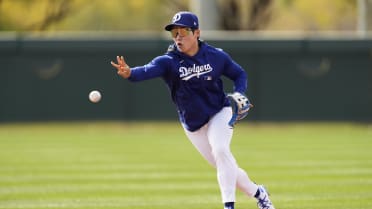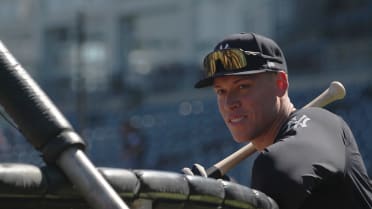Risk vs. reward: Here's Stras' 7-year outlook
This decade was quite an eventful one for Stephen Strasburg. And now the next one is going to be extremely lucrative.
Strasburg's new, record-breaking contract with the Nationals is going to pay him $245 million over the next seven seasons -- an average of $35 million per year -- a source told MLB.com's Mark Feinsand. While the club has not confirmed the deal, once it becomes official, Strasburg will be the highest-paid pitcher in MLB history, both in terms of total dollars and average annual value.
The relationship between the Nationals and Strasburg goes back to when they made the greatly hyped college pitcher the No. 1 overall pick in 2009, he authored one of the most explosive debuts in MLB history in '10. What followed was rookie success, Tommy John surgery, the highly controversial '12 shutdown and years of success -- interrupted by an injury here or there -- that nonetheless kept many people wanting more.
Strasburg left all that behind in 2019, when he closed the decade in style. The right-hander stayed healthy, led the National League in innings (209) and wins (18), struck out a career-high 251 batters, and posted a 3.32 ERA to spur a fifth-place NL Cy Young Award finish. Last, but certainly not least, his postseason heroics (36 1/3 innings, 1.98 ERA) netted him a ring and World Series MVP honors.
The 31-year-old opted out of his contract after that, passing up the heavily deferred $100 million that was left on the deal over the next four years. The decision paid off with Monday's agreement, but will it pay off for the Nationals?
Here are a couple of ways to gauge what Strasburg might provide moving forward.
The projections
As with remaining free agent Gerrit Cole, MLB.com received projections for Strasburg’s next seven seasons from Brian Cartwright, the developer of the Oliver projections, as well as a writer and consultant to MLB teams. While Cole was projected to roughly maintain the same level of effectiveness for years to come, Strasburg’s numbers follow a more typically cautious route.
On one hand, Strasburg has a long track record of success, producing no higher than a 3.74 ERA and no lower than a 114 ERA+ in every year of his career. His 3.17 career ERA and 130 ERA+ both rank seventh among the 88 active starters with at least 750 career innings, backed up by a 2.96 FIP (fourth) and 29.1 percent strikeout rate (third).
On the other hand, Strasburg is two years older than both Cole and fellow righty Zack Wheeler -- who signed with the Phillies -- as he heads into his age-31 season in 2020.
Here is what Cartwright’s projections have in store for Strasburg:
Strasburg’s projected ERA by year
2020: 3.17
2021: 3.26
2022: 3.37
2023: 3.47
2024: 3.60
2025: 3.81
2026: 4.10
There is a steady if undramatic decline here -- but beginning from a lofty place.
Strasburg’s projected 3.17 ERA for next season would match his career mark and actually would be his lowest since 2017. He is projected to finish with a sub-3.50 ERA over each of the next four years, something that only four starters (minimum 100 innings) did from 2016-19: Justin Verlander, Max Scherzer, Clayton Kershaw and Kyle Hendricks. Even the 4.10 ERA in that last year -- when Strasburg is 37 -- would have been far better than average for a Major League starter in 2019.
The next step was for MLB.com senior data architect Tom Tango to take the projections for Strasburg’s rate stats, combine them with his projections for innings pitched, and produce WAR values.
Strasburg’s projected IP, WAR by year
2020: 200 IP, 5.1 WAR
2021: 180 IP, 4.4 WAR
2022: 162 IP, 3.7 WAR
2023: 146 IP, 3.2 WAR
2024: 131 IP, 2.7 WAR
2025: 118 IP, 2.1 WAR
2026: 106 IP, 1.5 WAR
Total: 1,043 IP, 22.7 WAR
Average: 149 IP, 3.2 WAR
Those numbers might seem conservative, as projections often are, and Strasburg did throw far more innings (1,187 1/3) over the past seven seasons. But he did that at ages 24-30, not 31-37, and his health record should cause some concern.
There was, of course, the 2010 Tommy John surgery. But that led to just one of Strasburg’s 10 career stints on the injured list, including seven from 2015-18 before he remained on the field this past season. Going back to ‘15, Strasburg ranks only 34th in the Majors in innings, and his history of injuries is probably the biggest reason to for caution. As Russell Carleton -- who now works in the Mets' front office -- wrote for Baseball Prospectus a few years ago, the best predictor of pitcher injury is past injury.
Yet that modest innings total didn’t stop him from ranking ninth in pitcher WAR since 2015, which speaks to how Strasburg’s ability can help make up for a somewhat lighter workload. These projections have him with 5.1 WAR in 2020 -- equal to his average over the past three years -- and falling off from there. Still, that total of 22.7 WAR would be more than all but 14 pitchers (including Strasburg) generated over the past seven years, about equal to Jon Lester (21.4) or Cole (23.4).
The recent historical precedent
Besides projecting Strasburg, we also can look at how comparable pitchers have fared at the same point in their careers and establish some possible futures for him. To do that, we’ll focus on Strasburg’s past three seasons, when he was worth 15.3 WAR (per Baseball Reference) from ages 28-30. Let’s find some comps, with these criteria:
• Born in 1975 or later (since pitchers of previous generations were used much differently)
• Produced at least 12 WAR from ages 28-30
• Is now through at least his age-35 season
The result was a group of 13 pitchers, some of whom feel like closer fits for Strasburg than others. Together, they averaged 133 starts and 12.1 WAR over the ensuing five seasons, and individually, they speak to the wide range of outcomes in play here.
Best-case scenarios: Roy Halladay (31.3 WAR), Zack Greinke (26.8), Verlander (22.9)
Halladay clinched his Hall of Fame credentials over his final two seasons in Toronto and first three in Philadelphia, with a Cy Young Award and two other runner-up finishes. Greinke posted a 1.66 ERA at 31 and has remained a standout since, with another All-Star campaign at 35 this past season. Verlander actually hit a rough patch at this point in his career (4.54 ERA at 31) but soon recovered and, in Houston, reemerged as one of the game’s elite pitchers.
Solid production: Cole Hamels (18.9), Mark Buehrle (17.5)
Hamels, who began his age-31 season with the Phillies, has remained effective while moving to the Rangers and then the Cubs, but hasn’t been quite the same force he once was. The steady Buehrle never put up gaudy stats (108 ERA+) but threw 200-plus quality innings every year.
Modest outlook: Roy Oswalt (9.2), Bronson Arroyo (8.3), CC Sabathia (7.1)
Oswalt and Sabathia both experienced some ups and downs over the next five years, though the former was done at 35, while the latter went on to pitch three more seasons. Arroyo was a bit like Buehrle, throwing more than 200 innings per year, but with a slightly below-average 98 ERA+.
The red flags: Livan Hernandez (5.2), Johan Santana (4.8), Aaron Harang (2.7), Dan Haren (1.5), Jered Weaver (1.3)
None of Santana, Haren and Weaver pitched all the way through age 35, with Santana notably seeing injuries curtail a career that could have been bound for Cooperstown. Hernandez (162 starts) and Harang (131) both pitched plenty, but with well below-average results.
It is worth noting, however, that Strasburg’s superb 141 ERA+ from ages 28-30 was in a different class from Arroyo, Harang, Haren, Hernandez and Buehrle, each of whom was under 125 -- while throwing far more innings. Meanwhile, two pitchers in the group exactly matched that 141 ERA+ over those three seasons: Halladay and Santana.
That pair still speaks to the hope and anxiety facing teams interested in Strasburg. The talent is there for continued stardom, but so is the possibility of physical issues interfering. The Nationals are now counting heavily on the former.
Andrew Simon is an editor and writer for MLB.com.




